Women in Science: Guiding the Future of the Atchafalaya Basin
The Atchafalaya Basin is the largest wetland and swamp in the United States – encompassing ~ 1.4 million acres in south Louisiana between the Atchafalaya River and the Gulf of Mexico. Altered hydrology has greatly impacted the overall health of the basin, with some areas experiencing stagnate waters and long-term flooding, and others receiving either too little or too much sediment from the Atchafalaya River. Mission: Water magazine highlighted the large-scale restoration effort The Nature Conservancy (TNC) is spearheading in the basin. Check it out in the latest issue, released this summer.
>>> Download Mission: Water
The Nature Conservancy has purchased over 5,000 acres near Bayou Sorrel as their first step in conserving the basin and restoring the natural water flow through the area. Joe Baustian, an ecologist with TNC, is using multiple YSI EXO sondes deployed throughout the area to collect baseline water quality data which will shed light on the current conditions and aid researchers as they develop a restoration plan. The Nature Conservancy, through the help of private donors, has also funded four fellowships to graduate students at nearby Universities to research the historical and current ecosystem conditions found within the basin.
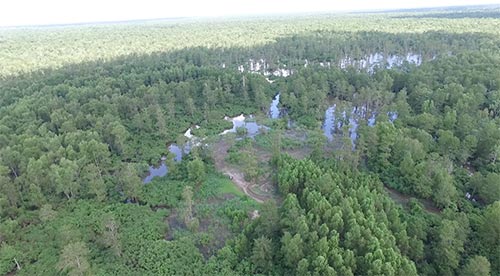
Meet the fellows: 4 women in science whose combined research will help guide future hydrologic restoration planning in the Basin.
Lauren Kong
Nicholls State University – Dr. Chris Bonvillain
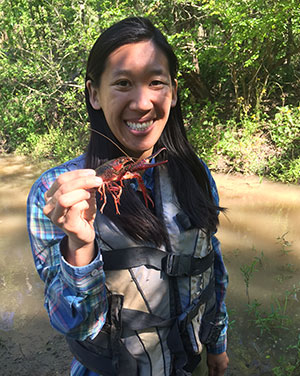 Lauren Kong, under the direction of Dr. Chris Bonvillain at Nicholls State University, is characterizing the population of red swamp crawfish in the Atchafalaya Basin. She is looking at the sex, size, age at sexual maturity for males, and hemolymph protein concentration in crawfish at 14 sites throughout the basin to assess the overall population health.
Lauren Kong, under the direction of Dr. Chris Bonvillain at Nicholls State University, is characterizing the population of red swamp crawfish in the Atchafalaya Basin. She is looking at the sex, size, age at sexual maturity for males, and hemolymph protein concentration in crawfish at 14 sites throughout the basin to assess the overall population health.
There are hypoxic zones (areas with less than 2.0 mg/L of dissolved oxygen) throughout the basin. Using the water quality data collected with the YSI Professional Plus, Lauren is able to compare the population characterization at both hypoxic and normoxic sites, where the dissolved oxygen concentration is much higher. This research has implications for crawfish health. Lauren explained, “Dr. Bonvillain’s previous research suggested crawfish in hypoxic areas are generally smaller, less abundant, and have less blood protein, and we are looking to see if the same holds true for crawfish on The Nature Conservancy's Atchafalaya Basin.”
Leslie Valentine
University of Louisiana at Lafayette Geosciences – Dr. Brian Schubert
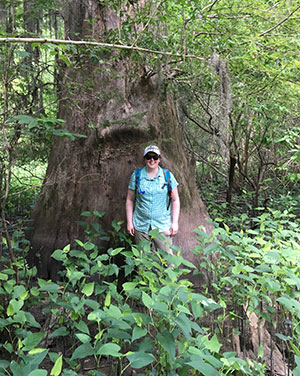 As part of her Master’s thesis research at the University of Louisiana at Lafayette, Leslie Valentine looked at sediment accretion, plant stress using carbon isotopes, and tree canopy changes within 5 tracts of land recently acquired by The Nature Conservancy within the Atchafalaya Basin. Altered hydrology within the basin, and the formation of and filling in of distributary channels, can impact the overall health of the forest. Using GIS mapping tools, Leslie found that over 10% of the tree canopy within the basin had changed from full canopy to partial canopy in just 40 years. She also assessed drought and flooding events and found precipitation and temperature correlated with plant stress.
As part of her Master’s thesis research at the University of Louisiana at Lafayette, Leslie Valentine looked at sediment accretion, plant stress using carbon isotopes, and tree canopy changes within 5 tracts of land recently acquired by The Nature Conservancy within the Atchafalaya Basin. Altered hydrology within the basin, and the formation of and filling in of distributary channels, can impact the overall health of the forest. Using GIS mapping tools, Leslie found that over 10% of the tree canopy within the basin had changed from full canopy to partial canopy in just 40 years. She also assessed drought and flooding events and found precipitation and temperature correlated with plant stress.
Sarah Wood
Louisiana State University – Dr. John White
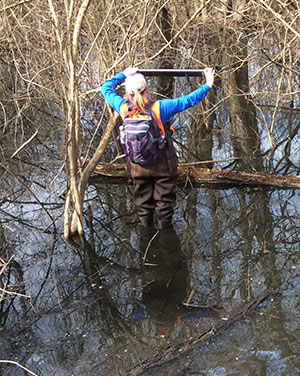 Sarah Wood, Louisiana State University, recently defended her Master’s thesis research on water quality improvements through nitrate reduction and soil quality in the Atchafalaya Basin. “Riparian wetlands play an important role in denitrification (removing the nitrate from the water column)…this is extremely important for Louisiana as we see the impacts of increased nutrient pollution through the growing Dead Zone in the Gulf of Mexico” says Wood. Sarah is using feldspar markers to look at nutrient (Carbon, Nitrogen, and Phosphorus) accretion rates in the sediments of the basin. This research documented the initial conditions and will serve as baseline data prior to the restoration efforts.
Sarah Wood, Louisiana State University, recently defended her Master’s thesis research on water quality improvements through nitrate reduction and soil quality in the Atchafalaya Basin. “Riparian wetlands play an important role in denitrification (removing the nitrate from the water column)…this is extremely important for Louisiana as we see the impacts of increased nutrient pollution through the growing Dead Zone in the Gulf of Mexico” says Wood. Sarah is using feldspar markers to look at nutrient (Carbon, Nitrogen, and Phosphorus) accretion rates in the sediments of the basin. This research documented the initial conditions and will serve as baseline data prior to the restoration efforts.
Alicia McAlhaney
Louisiana State University – Dr. Richard Keim
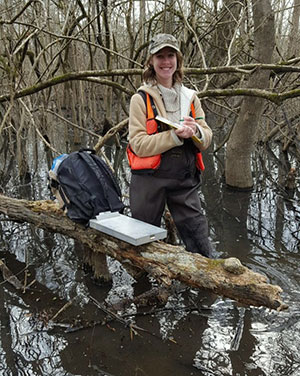 Alicia McAlhaney is passionate about freshwater wetlands and wetland restoration. After finishing her Bachelor’s Degree in Forestry at Clemson University, she moved to Louisiana to start her graduate degree at Louisiana State University working under Dr. Richard Keim. Alicia is looking at water quality/hydrological data along with dendrochronology (tree-ring dating) of Bald Cypress and Black Willow trees, to assess the overall forest health and response to hydrologic changes at sites within the Atchafalaya Basin. Using historical data and modeling as well as new data collected with the EXO2, this research will shed light on the site quality and help determine and guide restoration efforts by The Nature Conservancy.
Alicia McAlhaney is passionate about freshwater wetlands and wetland restoration. After finishing her Bachelor’s Degree in Forestry at Clemson University, she moved to Louisiana to start her graduate degree at Louisiana State University working under Dr. Richard Keim. Alicia is looking at water quality/hydrological data along with dendrochronology (tree-ring dating) of Bald Cypress and Black Willow trees, to assess the overall forest health and response to hydrologic changes at sites within the Atchafalaya Basin. Using historical data and modeling as well as new data collected with the EXO2, this research will shed light on the site quality and help determine and guide restoration efforts by The Nature Conservancy.
YSI would like to congratulate these hard-working researchers on their fellowships and wish them luck in their future endeavors with The Nature Conservancy.

Additional Blog Posts of Interest
Life After Deepwater Horizon | Remediation Efforts on the Gulf of Mexico
Drilling into the Abyss | Understanding Sea Level Rise
Waterkeepers at the Third Pole | Protecting the Himalayas